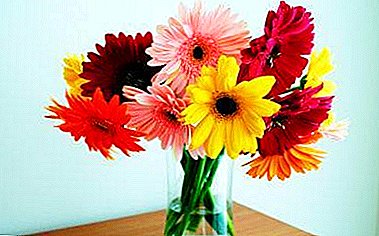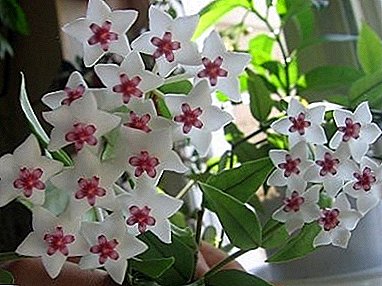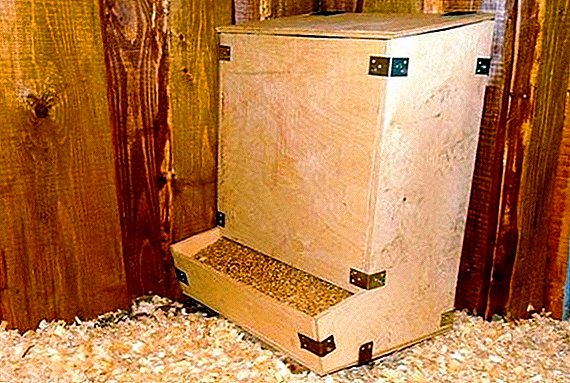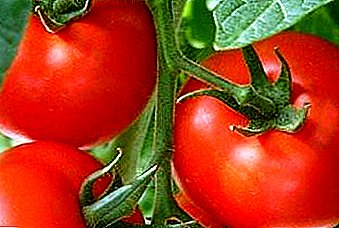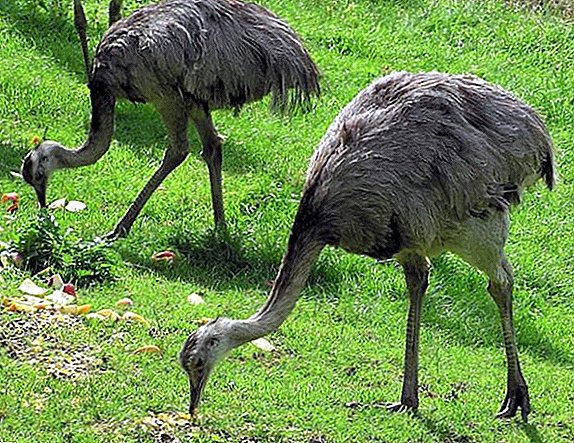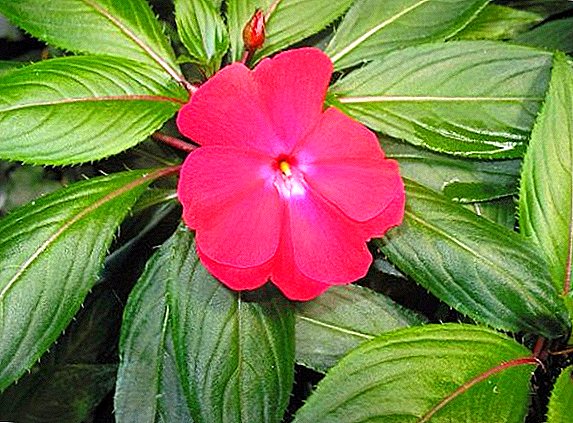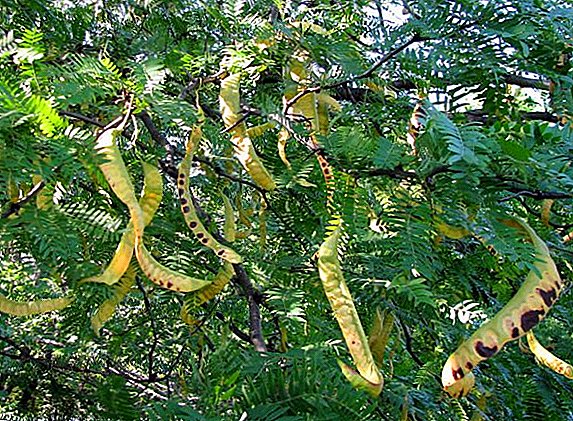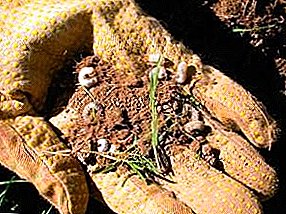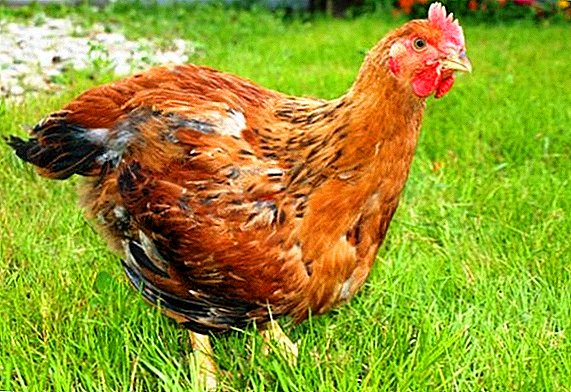 Broilers are hybrids of breeds of hens with high performance and precocity. Now breeds of chickens are bred, which are almost as unpretentious as the usual domestic chickens. The owners of household plots are most interesting chicken meat and egg direction. These are the breeds of color broilers. Consider what breeds of color broilers are now popular and their productive qualities.
Broilers are hybrids of breeds of hens with high performance and precocity. Now breeds of chickens are bred, which are almost as unpretentious as the usual domestic chickens. The owners of household plots are most interesting chicken meat and egg direction. These are the breeds of color broilers. Consider what breeds of color broilers are now popular and their productive qualities.
Features color broilers
Color broilers have several features:
- strong bones:
- well defined musculature;
- a large body with an elongated body, a broad chest and a small head;
- variegated plumage;
- quick weight gain combined with high egg production;
- nestlings are distinguished by rapid and uniform maturation;
- high chick survival rate (94-98%);
- a large percentage of white meat;
- unpretentious content. They can be kept in the same conditions as ordinary domestic chickens.

Color broiler breeds
Consider the common breed of colored broilers and their description.
Did you know? The egg is formed inside the body of the chicken for about a day.
Red bro
This broiler was bred by English breeders when crossing two breeds of chickens - Malaysian and Cornish:
- From the parents of fighting breeds they got strong legs and well-developed muscles.
- Color plumage reddish-brown tones, rarely white color appears.
- These hybrids, like all broilers, quickly gain weight. In the six months of age, females weigh about 3 kg, and males - about 4.5 kg.
- At the same time, they have egg production, as in chickens of the egg direction. Scratch starts from 6 months of age.
- Red Bro is unpretentious to the conditions of detention and have good health. They are perfectly adapted to the usual temperature regime of the house, they can be kept as simple domestic chickens.
- They do not consume large amounts of feed and can eat food of different quality.
- They can be successfully maintained in the backyard.
- They have meat of good taste, but somewhat fibrous.
The fighting breeds of chickens include such as Sumatra, American warrior, bantamki, Chamo, Kulangi.

Master gris
This breed of colored broilers was bred by the French:
- The color of feathers is predominantly white, it can also be gray-white.
- These are hens of meat and egg direction.
- They are hardy and unpretentious and can be kept in various conditions, including in conditions of limited walking. They have an excellent chick survival rate of 98%.
- They are characterized by rapid maturation - the hens begin to give eggs from the age of 4 months. Males can reach 7 kg, and females weigh about 4 kg.
- Their meat is tasty, low-fat, but not dry.
- Egg production is high, at the level of egg breeds.

Hungarian giants
This hybrid was bred in Hungary when crossing Orlington and local breeds:
- They have a large squat body and color of feathers of red-brown and reddish colors. In cocks, feather color on the back is darker, and in the tail there are usually black feathers.
- Small, poorly pronounced comb, red head without feathers.
- Hungarian giants broilers are so unpretentious that they perfectly suit the beginning poultry breeder. They tolerate cold due to thick plumage. They can be kept in walking conditions.
- Hens of this breed have not lost their brooding instinct and are good moms. They incubate chickens responsibly and care for them when they are born. The survival rate of chicks is 98%.
- It should be noted that the feed of these birds must contain a sufficient amount of protein, otherwise the weight gain will not be intense. It is best to use ready-made feed. This breed tolerates a change in feed, green food is given to them only as an additive. For hens and chickens for meat, it is better to make a separate diet, since the overweight hens begin to nestle badly.
- They have a high egg production and start rushing at 4-5 months. They quickly gain weight. A three-month-old chicken weighs 2 kg, and by half a year they already reach maximum weight.

Cornish chickens
- Broiler Cornish chickens are gaining weight well and are unpretentious in content. Already at 7 weeks, Cornish broilers reach a weight of about 2 kg.
- This breed can be kept in different conditions and give it the usual feed. Ripen and begin to rush to 7-9 months, but do not differ in high egg production, moreover, the eggs have several fragile shells of brownish tones. In the fourth year of life, egg production falls.
- In laying hens, the nesting instinct is well developed, but the nest should be approached carefully, as they actively protect their offspring, although they have a calm character. The hatchability of chickens from eggs is 70%, but the survival rate of the obtained young is very high.
- These chickens are prone to obesity and feed should be dosed for them.
Did you know? This is the very first breed of broilers bred from the 1930s. In the formation of the breed "Cornish" ("Cornish") participated in the "Old English Fighter", "Red Azil" and "Malaysian" breed. When crossed with the hens of the breed "White Plymouth", a productive cross with a good weight gain and excellent meat quality was obtained.

Foxy chick
The name of these broilers is translated from English as "fox chicken" because of the orange tones present in the plumage of these chickens. Since they were brought to us from Hungary, they are also called Hungarian chickens.
This breed belongs to the meat and egg direction.
The meat-egg breeds of chickens include such ones as master gray, velzumer, Kyrgyz gray, Moscow black, galan, California gray, Bress gal, tetra.
It has high productive characteristics and unpretentious content. At the age of 42 days, the average weight of Foxy Chick chickens is 1.37 kg. These broilers can be kept like ordinary domestic chickens, and they are perfect for the farmstead. 
Naked neck
This breed is common in Germany and Romania, its origin is unknown. Its main distinguishing feature is the naked neck, as a result of which it is called even naked. Color of plumage can be any.
A feature of the content of Naked Neck chickens is their good tolerance to low temperatures. In winter, egg production almost does not fall. These are medium-heavy chickens in meat and egg direction. The hens well incubate chickens, and the survival rate of the offspring is very high.
Unpretentious to feed, but for good productive indicators it should be enough and it should be balanced. This bird needs walking. On walks, she can replenish her diet with pasture feed, which saves other feed. At temperatures below -15 ° C walks should be reduced. 
Productivity
Indicators of productivity of color broilers are given in the table:
| Breed | Male weight, kg | Female weight, kg | Egg production, pcs | Egg weight, gr |
| Red bro | 4,5-6 | 3 | up to 300 | 60-65 |
| Master gris | up to 7 | up to 4 | 280-300 | 65-70 |
| Hungarian giants | 4-5 | 3-4 | 200-300 | 55 |
| Cornish chickens | 5 | 4 | 120 | 55-60 |
| Foxy chick | 5-7 | 4 | 250 | 65-70 |
| Naked neck | 3 | 2,5 | 160-210 | 60 |
Content
To obtain high returns from color broilers, they should be provided with appropriate conditions and properly fed. 
Growing rules
When growing broilers of non-ferrous breeds, you should adhere to the following recommendations:
- the area of the room for maintenance should be spacious. Per 1 square meter should be no more than 10 chickens or 3-4 adults;
- in the autumn-winter period, the coop must be heated;
- for the required lighting in the room there should be windows at the rate of 1 sq. m per 10 sq. m of floor space;
- requires the presence of feeders and drinkers. Feeding trough dimensions should be 10 cm per chicken. Drinking bowls need to be constantly cleaned and ensure that the drinking water is fresh;
- temperature in the first days for chicks should be around + 25 ° C, and then every 7 days it decreases by 2 ° C. The optimal mode for keeping adult chickens is + 12-18 ° C;
- the room should be ventilated, but in this case there should be no drafts, dampness;
- the illumination should also be sufficient, about 13-14 hours;
- straw, sawdust, peat are excellent for bedding. The litter needs to be cleaned as it gets dirty, and a full replacement is made at least once a year;
- you must constantly monitor the cleanliness of the hen house. Complete room disinfection should be carried out at least once a year.
It is possible to contain color broilers not only in the hen house, but also in cell conditions.
Excessive moisture can cause colds in chickens, especially in young. If the birds begin to cough, then it is necessary to warm the room, to monitor the ventilation. In this case, chickens are given drugs like "Tetramisol 10", "Baykoks", "Enroksil" and others.  In order to reduce the risk of dangerous diseases that can cause the death of chickens, vaccination of chickens should be carried out in a timely manner.
In order to reduce the risk of dangerous diseases that can cause the death of chickens, vaccination of chickens should be carried out in a timely manner.
Another common problem is foot disease. If chickens start to limp, then it is important to determine the cause of this phenomenon. This may be food of poor quality, lack or excess of minerals and vitamins, mold and so on.
If the cause is calcium deficiency, then meat and bone meal, limestone, shells, crushed eggshell are added to the feed. It will not be superfluous to add milk, sour milk, whey to the diet.
It will be useful to add raw fish to the diet - this product contributes to weight gain and increases egg production.
Learn how to increase egg production in chickens in the winter and what vitamins are needed for this.
The reasons for low weight gain in young animals can be the following:
- improper room temperature;
- too large area for walking chickens;
- lack of protein and essential amino acids.

Causes of death of young stock can be the following:
- low light;
- poor ventilation and excessive dampness;
- unsanitary conditions and lack of disinfection of the room, feeders, watering systems, dirty water for drinking;
- lack of vaccination;
- poor care in the first days of life - did not give the necessary antibiotics and vitamin complexes;
- diseases of coccidiosis or colibacillosis;
- lack of nutrition.
Important! The main causes of bird cannibalism are excessive lighting of the premises for maintenance and lack of nutrients in the diet.
Diet
Broilers are important to feed properly. Good for the diet of colored broilers suitable factory balanced feed. It contains the necessary amount of proteins, vitamins and minerals that provide a stable increase in weight in young animals. 
Feeding adults should be carried out according to the established schedule, at a certain time - at least three times a day. Chickens are fed more often - in the first 10 days every two hours, from 11 to 45 days every 3 hours, then the young are fed every 4 hours.
The main food for broilers of colored breeds are the following components:
- feed grain crops (wheat, oats, millet, corn, bran, etc.);
- maggots and worms should be included in the diet 2-3 times a week;
- food waste;
- fruits and vegetables in boiled or raw (carrot, potatoes, cabbage, beets, zucchini, etc.);
- greens and grass (nettle, knotweed, clover, etc.);
- wet mash.

Food for colored broilers can be independently, using the following recommendations:
- crushed corn grain - 400 g;
- crushed wheat grain - 200 g;
- ground oats - 100 g;
- chopped barley grain - 50 g;
- sunflower cake - 150 g;
- low-fat cottage cheese - 200 g;
- fish or meat and bone meal - 60 g;
- yeast for baking - 2 g
The listed ingredients are thoroughly mixed with yogurt, whey, or at least water. The resulting mixture is given at the rate of 10-40 grams per chicken, depending on its age.
Important! Buckwheat and rice for feeding chickens should be used only in the form of boiled cereals, as raw they swell in the goiter of chickens. And they need to give in limited quantities.
It is necessary to ensure that the water in the drinkers is always, and always fresh, to avoid problems with the intestines. In case of severe frosts, it is advisable to warm up some drinking water. 
Chickens are recommended to give 1-2 grams of yeast each for better weight gain.
Separately in the feeders should be coarse sand or fine gravel. These components contribute to a better digestion of food, as well as improve metabolic processes and prevent the appearance of cuticle.
Sasso - color broiler
An increasing popularity is now becoming the breed of color broilers Sasso.
What is special
Color Sasso broiler was bred by French breeders.
The main features of the breed are:
- small head;
- broad chest;
- strong body, but low. yellowish skin;
- strong paws of yellow color;
- red color in plumage;
- comb, as well as earrings of relatively small size;
- short wings;
- small beak of light color.

A distinctive feature of the chicks of this meat breed is thicker, but short legs. Chicks daily age always have a white color.
The breed of colored broilers is highly productive.
Chickens have a weight of about 4 kg, and larger males are between 6 and 7 kg on average. At two months, young individuals reach a weight of 2-3 kg and can be taken for meat. Chickens of this type quickly gain weight in a natural way without special additives - during the day about 60 grams.
This feature of the breed makes it very attractive for entrepreneurship, as there is a quick return on investment.
The Sasso breed is also distinguished by decent egg production - about 300 pieces per year. But It is worth noting that, in comparison with other breeds, these chickens start laying eggs somewhat late in the age of 6-8 months, and sometimes even after reaching one year. 
How to grow
Broilers Sasso breed unpretentious in the care and food.
But, to ensure rapid weight gain and egg production for these chickens, you must adhere to the following recommendations:
- optimum temperature should be + 18 ° C;
- provide room ventilation and access to fresh air, but there must be no drafts;
- should not be damp in the room;
- monitor the dryness and cleanliness of the room — disinfect the room in a timely manner, monitor the cleanliness of feeders and drinkers, as well as timely clean and replace floor litter;
- exercise regular walking on the street.
What to feed
The diet for the Sasso chicken breed is no different from that for other meat breeds. The main thing is that the birds eat their fill. Adults should be fed at least three times a day. Perfect ready-made factory feed, which includes all the nutrients, essential vitamins and minerals. 
Such foods, taking into account their age and growing characteristics, are starting, growth and finishing. The only downside is the high price. Therefore, they often produce food for themselves.
The main elements of the diet are the following feed:
- mixtures of grain - wheat, oats, millet, corn, barley, bran;
- sunflower cake;
- fruits and vegetables;
- greens and grass;
- cottage cheese;
- meat and bone meal or fish meal;
- baker's yeast;
- wet mash.
Grain mixtures are useful for making with milk or kefir.
In the first days, chickens are given finely chopped boiled eggs, and after the crushed grain. 
In 14 days, you can enter in the food boiled potatoes, sunflower cake or peanuts. Giving the necessary vitamins and minerals.
For the formation of the skeleton and the strength of the bones, it is necessary to give chalk, fish, dairy products.
Breed benefits
Many breeders and farmers choose Sasso broilers for breeding because of the following breed advantages:
- resistance to many diseases;
- high resilience and survival;
- high productivity;
- quick weight gain;
- frost resistance;
- unpretentious care;
- low cost;
- availability and reasonable cost;
- excellent taste of meat.

Color broilers are distinguished by their rapid weight gain and high egg production. They are unpretentious, and they can be kept in ordinary chicken coops. For a good return from these breeds, their proper nutrition and maintenance should be organized.
High performance characterized breed Sasso. Since these broilers are hybrids, at their breeding periodically it is necessary to purchase young stock or hatching eggs of these breeds.


